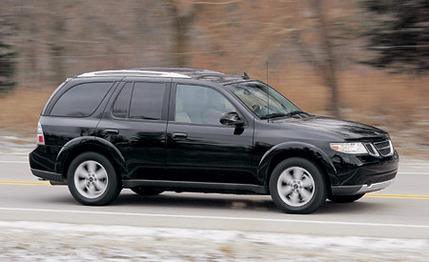
 Short Take Road Test
Short Take Road Test
With only three models, product-starved Saab has for some years been cast in the role of GM's redheaded stepchild. Here it is 2006, and the General is just getting around to bequeathing the sixth branding of its five-passenger GMT360 platform to its Swedish automaker.
In plain talk, that means Saab has been given a Chevy TrailBlazer to turn into a $40,000 luxury sport-utility vehicle. It's a tad late, seeing as how the TrailBlazer (and its clones, such as the GMC Envoy) is five years old. So old, in fact, that the oddly shaped stretched versions of these SUVs already came and went.
The 9-7X's basic formula is the same as that of other GM versions, including its powertrain choices: There's a 300-hp, 5.3-liter pushrod V-8 tested here (the 5.3i), as well as a 291-hp, 4.2-liter DOHC inline-six (the 4.2i), both with the venerable and sometimes harsh-shifting four-speed automatic. Many other mechanicals-suspension, steering, and brakes - were tweaked with an intent to reform some of the inherent truckiness of the body-on-frame, solid-rear-axle platform.
Head on, the 9-7X does a pretty decent impersonation of a Saab. Even parked next to another Saab, the well-integrated trapezoidal grille fits right in. Around the side are Saab-only 18-inch wheels, but the profile says TrailBlazer. The 9-7X wears no body cladding - that would have been state of the art when the TrailBlazer was introduced in 2001 - but now the no-plastic look is the norm. Clear taillights and an oval exhaust aren't much of a rear disguise.
Saab continues to insist on a center-mounted ignition and a flimsy foldout cup holder that carries almost nothing but a 12-ounce can, but most other changes take the 9-7X in the right direction. On the road, the Saab feels considerably more composed, with stiffer shocks and springs that go a long way to calm excess body motions, a steeper steering ratio that gets rid of some on-center slop, and stiffer calipers combined with a more aggressive pedal ratio that help to alleviate a previously soft brake. Combined with stickier 255/55R-18 Dunlop SP Sport 5000 tires, these changes amount to noticeable performance improvements: a 172-foot stop from 70 mph and 0.82 g on the skidpad, improvements of 38 feet and 0.14 g over the TrailBlazer. Throttle response is prompt, and the Saab scoots to 60 mph in a respectable 7.3 seconds. But there's still noticeable chassis flex over bumps. And compared with the sharp responses of unibody class leaders (the market is shifting away from body-on-frame) such as the Acura MDX or Cadillac SRX, the 9-7X feels clumsy, falling short in every dynamic category.
There's a price problem, too. The V-8-powered 9-7X starts at $41,240 (the inline-six knocks the price down $2000), which is $10,380 more than a V-8 TrailBlazer. Even worse, since the 9-7X's introduction, a better GMT360 has been released - the TrailBlazer SS, powered by the Corvette's 6.0-liter V-8. For $35,850, the 395-hp SS thrashes the Saab in a straight line, trimming the 0-to-60 run by 1.8 seconds, down to 5.5. Even though the 9-7X grips the pavement a hair better than the SS (with its 20-inch Goodyear RS-As), that TrailBlazer also benefits from many of the Saab's upgrades - quicker steering and stiffer suspension, for example - making it just as competent as the 9-7X.
For buyers who want nothing other than a Saab SUV, this is the only choice. Apparently, this group isn't very large because the highest sales volume in the seven months following the 9-7X's introduction was 685 units. For some perspective, in a given month Chevy sells about 30 times as many TrailBlazers, and even Porsche peddles nearly the same number of 911s. Then again, this isn't surprising. Remove the Saab blinders, and there's a world of other, better $40,000 sport-utes.